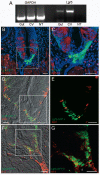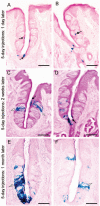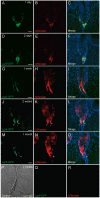Lgr5-EGFP marks taste bud stem/progenitor cells in posterior tongue
- PMID: 23377989
- PMCID: PMC3637415
- DOI: 10.1002/stem.1338
Lgr5-EGFP marks taste bud stem/progenitor cells in posterior tongue
Abstract
Until recently, reliable markers for adult stem cells have been lacking for many regenerative mammalian tissues. Lgr5 (leucine-rich repeat-containing G-protein-coupled receptor 5) has been identified as a marker for adult stem cells in intestine, stomach, and hair follicle; Lgr5-expressing cells give rise to all types of cells in these tissues. Taste epithelium also regenerates constantly, yet the identity of adult taste stem cells remains elusive. In this study, we found that Lgr5 is strongly expressed in cells at the bottom of trench areas at the base of circumvallate (CV) and foliate taste papillae and weakly expressed in the basal area of taste buds and that Lgr5-expressing cells in posterior tongue are a subset of K14-positive epithelial cells. Lineage-tracing experiments using an inducible Cre knockin allele in combination with Rosa26-LacZ and Rosa26-tdTomato reporter strains showed that Lgr5-expressing cells gave rise to taste cells, perigemmal cells, along with self-renewing cells at the bottom of trench areas at the base of CV and foliate papillae. Moreover, using subtype-specific taste markers, we found that Lgr5-expressing cell progeny include all three major types of adult taste cells. Our results indicate that Lgr5 may mark adult taste stem or progenitor cells in the posterior portion of the tongue.
Copyright © 2013 AlphaMed Press.
Figures




Similar articles
-
Single Lgr5- or Lgr6-expressing taste stem/progenitor cells generate taste bud cells ex vivo.Proc Natl Acad Sci U S A. 2014 Nov 18;111(46):16401-6. doi: 10.1073/pnas.1409064111. Epub 2014 Nov 3. Proc Natl Acad Sci U S A. 2014. PMID: 25368147 Free PMC article.
-
Cell lineage mapping of taste bud cells and keratinocytes in the mouse tongue and soft palate.Stem Cells. 2009 Feb;27(2):442-50. doi: 10.1634/stemcells.2008-0611. Stem Cells. 2009. PMID: 19038788 Free PMC article.
-
Lgr5 Identifies Progenitor Cells Capable of Taste Bud Regeneration after Injury.PLoS One. 2013 Jun 18;8(6):e66314. doi: 10.1371/journal.pone.0066314. Print 2013. PLoS One. 2013. PMID: 23824276 Free PMC article.
-
Wnt signaling, lgr5, and stem cells in the intestine and skin.Am J Pathol. 2009 Mar;174(3):715-21. doi: 10.2353/ajpath.2009.080758. Epub 2009 Feb 5. Am J Pathol. 2009. PMID: 19197002 Free PMC article. Review.
-
In vivo fate tracing studies of mammalian taste cell progenitors.Ann N Y Acad Sci. 2009 Jul;1170:34-8. doi: 10.1111/j.1749-6632.2009.04371.x. Ann N Y Acad Sci. 2009. PMID: 19686103 Free PMC article. Review.
Cited by
-
Squamous-columnar junction of Von Ebner's glands may be a significant origin of squamous cell carcinomas in the base of the tongue.Front Oncol. 2022 Nov 16;12:1029404. doi: 10.3389/fonc.2022.1029404. eCollection 2022. Front Oncol. 2022. PMID: 36465343 Free PMC article.
-
[Development and homeostasis of taste buds in mammals].Hua Xi Kou Qiang Yi Xue Za Zhi. 2018 Oct 1;36(5):552-558. doi: 10.7518/hxkq.2018.05.016. Hua Xi Kou Qiang Yi Xue Za Zhi. 2018. PMID: 30465351 Free PMC article. Chinese.
-
Cocktail Formula and Application Prospects for Oral and Maxillofacial Organoids.Tissue Eng Regen Med. 2022 Oct;19(5):913-925. doi: 10.1007/s13770-022-00455-3. Epub 2022 May 25. Tissue Eng Regen Med. 2022. PMID: 35612711 Free PMC article. Review.
-
MmuPV1-Induced Cutaneous Squamous Cell Carcinoma Arises Preferentially from Lgr5+ Epithelial Progenitor Cells.Viruses. 2022 Aug 11;14(8):1751. doi: 10.3390/v14081751. Viruses. 2022. PMID: 36016373 Free PMC article.
-
Immune Regulatory Roles of Cells Expressing Taste Signaling Elements in Nongustatory Tissues.Handb Exp Pharmacol. 2022;275:271-293. doi: 10.1007/164_2021_468. Handb Exp Pharmacol. 2022. PMID: 33945029
References
-
- Hamamichi R, Asano-Miyoshi M, Emori Y. Taste bud contains both short-lived and long-lived cell populations. Neuroscience. 2006;141:2129–2138. - PubMed
Publication types
MeSH terms
Substances
Grants and funding
LinkOut - more resources
Full Text Sources
Other Literature Sources
Medical
Molecular Biology Databases
Miscellaneous

